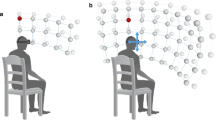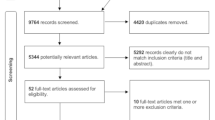Abstract
Computer-based assessment systems analysing the drawing responses from a test subject have been widely explored within the area of neuropsychological dysfunction diagnosis and rehabilitation monitoring. This study reports on the development of a quantitative marking system for the automated assessment of visuo-spatial neglect. Using a clinically established pencil-and-paper based method as a marking benchmark, a set of features are extracted and selected from a battery of computer-captured drawing tasks. Through the application of linear regression and data transformation, the novel system is shown to be effective in correlating against a clinically recognised scale, while simultaneously improving the efficiency of the testing process.





Similar content being viewed by others
References
Cherney LR, Halper AS (2001) Unilateral visual neglect in right-hemisphere stroke: a longitudinal study. Brain Inj 15:585–592
Cassidy TP, Lewis S, Gray CS (1998) Recovery from visuospatial neglect in stroke patients. J Neural Neurosurg Psychiatry 64:555–557
Halligan PW, Robertson IH (1992) The assessment of unilateral neglect. In: Crawford JR, Parker DM, McKinlay WW (eds) A handbook of neuropsychological assessment. Psychology Press, UK
Wilson B, Cockburn J, Halligan PW, Psych D (1987) Development of a behavioral test of visuospatial neglect. Arch Phys Med Rehabil 68:98–102
Fairhurst MC, Smith SL (1991) Application of image analysis to neurological screening through figure-copying tasks. Int J Biomed Comput 28:269–287
Chindaro S, Guest RM, Fairhurst MC, Potter J (2004) Assessing visuo-spatial neglect through feature selection and combination from geometric shape drawing performance and sequence analysis. Int J Pattern Recognit Artif Intell 18:1253–1266
Halligan PW, Marshall JC, Wade DT (1989) Visuo-spatial neglect-underlying factors and test sensitivity. Lancet 2:908–911
Teasdale TW, Hansen HS, Gade A, Christensen AL (1997) Neuropsychological test scores before and after brain-injury rehabilitation in relation to return to employment. Neuropsychol Rehabil 7:23–42
Hannaford S, Gower G, Potter JM, Guest RM, Fairhurst MC (2003) Assessing visual inattention: study of inter-rater reliability. Br J Ther Rehabil 10(2):72–76
Guest RM, Fairhurst MC, Potter JM, Donnelly N (2000) Analysing constructional aspects of figure completion for the diagnosis of visuospatial neglect. ICPR 4:4316–4319
Guest RM, Fairhurst MC (2002) A novel multi-stage approach to the detection of visuo-spatial neglect based on the analysis of figure-copying tasks. ASSETS, Edinburgh, pp 157–161
Guest RM, Chindaro S, Fairhurst MC, Potter JM (2003) Automatic classification of hand drawn geometric shapes using constructional sequence analysis. In: Proceedings of ICDAR
Liang Y, Guest RM, Fairhurst MC, Potter JM (2007) Feature-based assessment of visuo-spatial neglect patients using hand-drawing tasks. Pattern Anal Appl 10(4):361–374
Fairhurst MC, Guest RM, Donnelly N, Potter J, Deighton A, Patel M (1998) Engineering software tools for assessment of visuo-spatial neglect. In: Proceedings of IEEE colloquium on intelligent decision support in clinical practice. London
Martens H, Naes T (1989) Multivariate Calibration. Wiley, New York
Potter JM, Deighton A, Patel M, Fairhurst MC, Guest RM, Donnelly N (2000) Computer recording of standard test of visual neglect in stroke patients. Clin Rehabil 14:441–446
Mosteller F, Tukey JW (1977) Data analysis and regression. Addison-Wesley Pub Co, Massachusetts
Witten IH (2000) Data mining: Practical machine learning tools and techniques with JAVA implementations. Morgan Kaufmann, San Francisco
Weisberg S (1985) Applied linear regression. Wiley, New York
Jolliffe IT (1982) A note on the use of principal components in regression. Appl Stat 31(3):300–303
Hawkins DM (1973) On the investigation of alternative regressions by principal component analysis. Appl Stat 22(3):275–286
Nello C, John S-T (2000) An introduction to support vector machines and other kernel-based learning methods. Cambridge University Press, Cambridge
Arya S, Mount DM, Netanyahu NS, Silverman R, Wu. AY (1998) An optimal algorithm for approximate nearest neighbor searching fixed dimensions. J ACM 45(6):891–923
Elkan C (1997) Boosting and naive bayesian learning (Technical Report). Department of Computer Science and Engineering, University of California, San Diego
Altman DG (1991) Practical Statistics for Medical Research. Chapman & Hall, London
Feinstein AR (2002) Principles of medical statistics. CRC Press, London
Faundez-Zaiiuy M (2005) Data fusion in biometrics. IEEE Aerosp Electron Syst Mag 20(1):34–38
Hocking RR (1976) The analysis and selection of variables in linear regression. Biometrics 32:1–49
Partridge M (1998) Fast dimensionality reduction and simple PCA. Intelligent data analysis. 2(3):1–12
Norusis MJ (2004) SPSS 12.0 guide to data analysis. Prentice Hall, New Jersey
Martens H, Dardenne P (1998) Validation and verification of regression in small data sets. Chemom Intell Lab Syst 44:99–121
Bradley JV (1968) Distribution-free statistical tests. Prentice-Hall, New Jersey
Massey FJ (1951) The Kolmogorov–Smirnov test for goodness of fit. J Am Stat Assoc 46:68–78
Han J, Kamber M (2001) Data mining concepts and techniques. Morgan Kaufmann Publishers, San Francisco
De Maesschalck R, Estienne F, Verdú-Andrés J et al (1999) The development of calibration models for spectroscopic data using principal component regression. Internet J Chem 2:19
Hadi AS, Ling RF (1998) Some cautionary notes on the use of principal components regression. Am Stat 52(1):15–19
Bartolomeo P, D’Erme P, Perri R, Gainotti G (1998) Perception and action in hemispatial neglect. Neuropsychologia 36(3):227–237
Jackson SR, Newport R, Husain M, Harvey M, Hindle JV (2000) Reaching movements may reveal the distorted topography of spatial representations after neglect. Neuropsychologia 38(4):500–507
Chan YH (2003) Biostatistics 104: correlational analysis. Singapore Med J 44:614–619
Cohen J (1960) A coefficient of agreement for nominal scale. Educ Psychol Meas 20:37–46
Bengio S, Mariéthoz J (2004) The expected performance curve: a new assessment measure for person authentication. In: Proceedings of Odyssey 2004: the speaker and language recognition workshop, pp 9–16
Albert ML (1973) A simple test of visual neglect. Neurology 23:658–664
Acknowledgments
The authors gratefully acknowledge the support of the East Kent Hospitals NHS Trust Charitable Fund.
Author information
Authors and Affiliations
Corresponding author
Rights and permissions
About this article
Cite this article
Liang, Y., Guest, R.M., Fairhurst, M.C. et al. A computer-based quantitative assessment of visuo-spatial neglect using regression and data transformation. Pattern Anal Applic 13, 409–422 (2010). https://doi.org/10.1007/s10044-009-0172-z
Received:
Accepted:
Published:
Issue Date:
DOI: https://doi.org/10.1007/s10044-009-0172-z




